| Transylvanian War | |||||||||||||
|---|---|---|---|---|---|---|---|---|---|---|---|---|---|
| Date | July 27, 1950 - 1955 | ||||||||||||
| Location | Transylvania | ||||||||||||
| Result | Status quo ante bellum | ||||||||||||
| |||||||||||||
The Transylvanian War was a military conflict between the Kingdom of Romania and Hungary over the disputed territory of Transylvania, fought between July 27, 1950 and 1955. The war was the bloodiest war of the Post World War Two era.
Origins of the war[]
On 30 August 1940, under the Second Vienna Award, Germany and Italy forced Romania to give half of Transylvania to Hungary. The Hungarians received a region referred to as "Northern Transylvania", while "Southern Transylvania" remained Romanian. Hungary had lost all of Transylvania after World War I in the Treaty of Trianon. They had never surrendered the ambition of regaining the territory. the Antonescu government seriously considered a war with Hungary over Transylvania as an inevitability. Of course this new war would have to wait until after the expected "victory over the Soviet Union", which took place in 1945. for the last few years, large amounts of Romanian troops served on the Eastern front, in order to 'train' them, in preparation for any future war.
Opposing Forces[]
Romania[]

Romanian soldiers during an inspection by King Mihai I of Romania, May 10, 1950.
The Romanian Army gained much from its involvement in the Second World War. While the Romanian Army had been heavily influenced by the French Army in the interbellum years, they began to receive German military equipment during the war against the Soviet Union.
After the Second World War, Romania heavily rebuilt its army with large amounts of modern equipment brought from the Germans. While the Armed Forces was reorganised and retrained by German Wehrmacht advisors.
Especially the armoured forces were modernised. By 1950, most Romanian tank units were equipped with the R-5 tank, which was the Romanian designation for the German Panther II, fitted with a gyrostabilized 88 mm KwK L/71. These were crushingly superior to any Hungarian tank at that time, apart from the T34/88r and the 44M Tas. Other tanks in service at that time were leftovers from the Second World War, such as the T-4 medium tank (Pz.Kpfw. IV) and TACAM R-2 and TAC III (Sturmgeschütz III) self-propelled guns. The army had also been considerably motorised, with the addition of Opel-Blitz trucks, Famo halftracked tractors, Sd.Kfz. 251 halftracks and a few pre-war Malaxa tip UE haulers, which were mainly used to Tow anti-tank guns.

Malaxa carriers
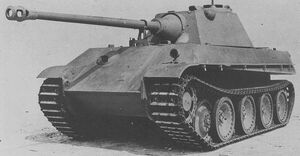
The Germans supplied Romania with many Panther IIs between 1945 and 1950.
The infantry not been developed much since the end of the Second World War. While new camouflage uniforms had been distributed, most soldiers were still equipped with World War 2 equipment, such as the Dutch M1923/27 helmets and ZB M1924 bolt-action rifles. However, submachine guns were becoming more common among NCOs, and the Orita M1941 was the most common version in use. Some elite units used Stg 44 assault rifles.
In terms of anti-tank weapons, the equipment were predominantly of German origin. Panzerfausts and Panzerschrecks were used on company level, while anti-tank guns such as the 75 mm PaK 40 were distributed at battalion and regiment level.
Artillery was the same as by the end of the war, most of them old Schneider and Škoda howitzers deriving from Austro-Hungary and France, with a few Czechoslovak howitzers from the interbellum period. Large stockpiles of Soviet artillery pieces, captured areas such as Odessa during the Second World War, was available in reserve or in units not yet modernised.

A Messerschmitt Me 262 of the Royal Romanian Air Force.
Especially the Forţele Aeriene Regale ale României (Royal Romanian Air Force) were expanded with German military assistance. Large numbers of jet-engined aircraft, mainly Messerschmitt Me 262 fighter jets, along with the modern jet-powered Arado Ar 234Cs, and the older IAR 80s and Henschel Hs 129. This gave the Romanians an emmence superiority over the Hungarians.
Despite many advantages with the German military assistance programme, many branches of the military, most notably the artillery, resisted the changes.
Hungary[]

Hungarian soldiers during a prewar military parade. Despite having an important role in Hungary both social and political, the army had since the end of the Second World War been neglected due to budget problems.
The Hungarian Army gained much from its involvement in the Second World War. The Hungarian Army had been heavily modernised during the war, and the situation was very different from that in 1938. Despite this, Hungary was content to administer its new territories, and despite its importance, the Armed Forces suffered budget problems and thus was not modernized.
The Hungarian Army relied on mostly equipment produced by themselves or obtained from the Germans during the Second World War. Their main tanks were the Hungarian-manufactured 41M Turan II medium tank and the T-4 (Pz.Kpfw. IV) medium tank. The army also consisted of several older Toldi II light tanks and Csaba armoured cars. However, Hungary was equipped with several self-propelled artillery, mainly the 43M Zrinyi II self-propelled howitzer and the Nimrod self-propelled anti-aircraft cannon. Relatively few of the new 34/88M, Hungarian version of captured T-34/85s armed with an 88 mm KWK 36 had had been distributed to the troops defending Transylvania. None of the new Hungarian-manufactured 44M Tas heavy tanks, produced with support from German military advisors such as Heinz Guderian, had entered service.

The 41M Turan II medium tank was the main tank of the Hungarian Army.
Motorisation of the army was one of the few successful reforms made in the army in that time. Hungarian Rába-Super 2,5t trucks, German 38M Hansa-Loyd halftracked tractors, and locally manufactured 43M Lehel armoured personnel carriers were in service in 1950.
The infantry had, like the rest of the army, not developed much from the end of the Second World War. While new camouflage uniforms had been distributed, most soldiers were still equipped with German-style Stahlhelms and the 35M Huzagol bolt-action rifle. The 39M and 43M sub machine guns, designed in the early 1940s, had been distributed to NCOs and elite troops, such as the paratroop units. Germany had supplied the Hungarians with MG 34 light machine guns, Panzerfausts and Panzerschrecks, but ammunition for anti-tank weapons were in small numbers.

A Focke-Wulf Ta 152 of the Royal Hungarian Air Force.
Artillery was the same as by the end of the war, most of them Škoda howitzers deriving from Austro-Hungary and German interbellum howitzers. 75 mm PaK 40 anti-tank gun had been supplied as well, but suffered problems due to lack of ammunition.
The Magyar Királyi Honvéd Légierő (Royal Hungarian Air force) was mostly equipped with obsolete Ta 152 Piston-engined fighter aircraft. Other aircraft in service were the ground attack aircraft Henschel Hs 129 and Junkers Ju-88 bomber. A small number of Me-262 jet fighters were due to be delivered to Hungary, but did not arrive by the beginning of the war.
The Conflict[]
1. The Opening Moves[]
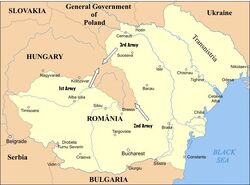
The opening stages of the Transylvanian War.
The first regular act of war took place on July 27, 1938, at 04:40, when Romanian field artillery opened fire on Hungarian artillery emplacements and garrisons in the Transylvania area. The artillery barrage proved to be quite accurate, and the Hungarians suffered up towards 25% losses.
A few hours later 25 Ar 234C bombers of the Royal Romanian Air Force bombed cities such as Budapest, Debrecen and Szeged, targeting centres of transportation and military installations. As a result of these bombing runs, around 500 people were killed, most of them civilians.
The Romanian Air force enjoyed almost complete air superiority, with only 3 aircraft shot down, two Ar 234C and a Me 262, all of them by the greatest Hungarian fighter ace of World War Two, Dezső Szentgyörgyi, who had decided to stay in the Hungarian Air Force due to the tension between the two countries. However, after what is considered a remarkable achievement, his Focke-Wulf Ta 152 was heavily damaged by another Me 262 and he was forced to return to base.
Massed Me 262 and Hs 129 wreaked havoc among the Hungarian troops, destroying over 40% of the armoured forces of the Hungarian Army.
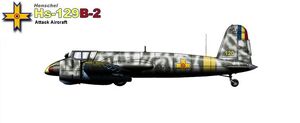
A Henshel Hs 129 of the Royal Romanian Air Force.
Operation Carpathian Freedom[]

Romanian Artillery shelling Hungarian Positions at the start of Carpathian freedom.
At 8:00 the Romanians launched 'Operation Carpathian Freedom'. The plan was for two armies, the First and the Third, to drive into Transylvania and cut it off from Hungary, thus preventing the Hungarian troops stationed there to retreat. Then the Second Army would drive up and retake Transylvania, eliminating all hostile forces.
The Hungarian situation was critical. Over 40% of the armoured forces of the Hungarian Army had been destroyed by the Henschel Hs 129 ground attack aircraft, and the Romanian Panther II tanks came as a shock to the crew of the old 41M Turan II tanks, who had only faced T-34s in combat. The Turan II was no match to the Panther II tanks, and many were lost in confrontations between the two main tanks. Against the other tanks of the Romanian Army, such as the T-4, the Hungarians outclassed the Romanians both in terms of equipment and tactics.

Hungarian soldiers and 43M Toldi III light tanks marches to the front supported by a 40M Nimrod.
However, the use of the Turan tanks was limited, due to the feroucious air attacks of the Romanian Air Force and the might of the Panther II. While the Turan II tanks were refitted with the 88 mm KwK 36 guns, which could penetrate the armour of the Panther IIs, the Hungarians had to rely on the obsolete Toldi II light tanks and the very efficient 43M Zrinyi II self-propelled howitzer and 40M Nimrod self-propelled anti-aircraft guns. Despite only being armed with a single 40 mm Bofors L/60 anti-aircraft cannon, both the Romanian pilots and the Romanian infantry feared it.
Though the Hungarians fought stubbornly with limited resources, they were outclassed in both men and material, and they were over and over again forced to fall back.
Responses to the attack[]
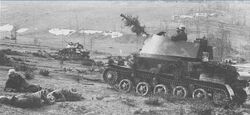
40M Nimrod self-propelled anti-aircraft guns firing on Romanian fighter jets during Carpathian Freedom.
Immediately after the declaration of war by the Romanian leader Ion Antonescu, the Regent of Hungary, Admiral Miklós Horthy, declared full mobilisation and called upon all Hungarians to fight for Transylvania. Mass mobilisation was immediately initiated, but Transylvania was cut off before the troops could be called up.
Meanwhile, both the German Führer, Adolf Hitler, and the German Minister of Foreign Affairs, Joachim von Ribbentrop, condemned the attacks on civilians, and urged both nations to end hostilities, and let the issue be solved by diplomacy. The representatives of all countries of the Anti-Comintern Pact also urged hostilities to be ended immediately. However, both the German government and the Anti-Comintern Pact withheld from taking side in the conflict, except for a few bordering countries.

Hungarian 105 mm 37M howitzers leaves to the front in Transylvania.
The Slovak Army mobilised its forces on the Slovak-Hungarian border, and the armoured forces and the Slovak Air Force was put on stand by, waiting for further instructions. The Slovak President, Jozef Tiso, secretly congratulated Romanian leader Ion Antonescu for their support of the Transylvanian cause, and their will to stand up to Hungary. Slovakia had, like Romania, a troubled relation with Hungary, which, had annexed one third of Slovakia's territory by the First Vienna Award and had occupied a small strip of land in Eastern Slovakia in a short border war in March 1939. Slovakia had tried to achieve a revision of the Vienna Award, but Germany did not allow that.
However, the German military advisors remained in both countries, and Me 262 fighter jets were secretly delivered to Hungary, but due to lack of training they were not immediately put into action. the German army secretly used the war as a test of their Military equipment, as much of the new equipment used on both sides (most notably the Panther II) was still in service with the German army.
The Link Up[]

Romanian infantry of the First Army marching through the Transylvanian countryside.
Despite ferocious resistance by the understrengthed and poorly equipped Hungarians, the Romanian attack was a large success, and at at 3:14 PM on August 5, the spearheads of the First and Third Armies linked up 30 km southeast of Nagyvárad (before 1940 known as Oradea). Transylvania was now cut off from the rest of Hungary, with over 100,000 Hungarian soldiers encircled in a pocket around the town of Zilah. Meanwhile, the Second Army started on August 6 to push northwards, but could only make slow progress due to heavy tough fortifications and stubborn resistance by the Hungarian Army.
On August 8 the Romanians captured Oradea after heavy fighting, and when the Hungarians retreated the Romanian soldiers were welcomed as liberators. However, the Hungarians had come over the shock of the lightning strike of the Romanian Armed Forces, and they were now planning a counterattack to retake Transylvania.
2. Operation Rákóczi Ferenc[]
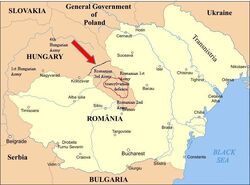
Operation Rákóczi Ferenc.

Hungarian 41M Turan II during the final stages of Operation Carpathian Freedom.
The Hungarian plan was to break through the Romanian lines in order to releave the the pocket of Hungarian troops in central Transylvania and then smash the armies driving in from the north. The Hungarian 4th Army was given the task of making the main assault. The Hungarian forces would use large numbers of 34/88M, 41M Turan II and 43M Turan III medium tanks, 43M Zrinyi II self-propelled howitzers and 30 of the new 44M Tas heavy tank in the operation, which was equal to the Panther II. Ammunition for Panzerschreck anti-tank weapons, Panzerfaust 100s were secretly obtained from the Germans, as well as Fliegerfaust AA missile launchers, to deal with the Romanian air superiority.
The offensive was launched on the 7th of October, 1950.
at first, the Hungarian troops could only make slow progress against stubborn Romanian defenders. however after a few days, the front collapsed, and the Hungarian Armour began to make progress. Romanian troops were hastily shifted to deal with the new threat.
Battle of Alesd[]
Alesd was a small town on the vital Transylvanian motorway in Romanian controlled Transylvania. the Hungarian 2nd and 3rd battalions, 1st Armoured division, drove towards the Romanian Troops holding the town, hoping to take it and split the Romanian 3rd army off from the Romanian 1st army. Defending the town were several companies of Romanian motorized troops (Vanatori Motorizata). on the 11th of October, 1950, the leading elements of the Hungarian Spearhead met up with the Romanian troops, and after a series of confused engagements pulled back to wait for the rest of the force. immediately upon arrival, the Hungarian Armour was sent against the Romanian lines. Romanian troops strongly defended, but were forced to withdraw in good order. During that night Romanian Armoured troops gathered to the west, as a counterattack was prepared to Re-Take Alesd.
Stalemate[]
For the next few years, from 1952 to 1953, there was stalemate. both sides were exausted, and neither able to make any major offensives. the Hungarians tried a limited offensive towards.

Romanian troops with a ZB-53 heavy machine gun at the Transylvanian Front during the Winter of 1950-51.

Hungarian troops at the Transylvanian Front during the Winter of 1950-51.
Operation Sicklecut[]
The romanian army had used the stalemate to bring new troops up and mobilize new divisions, and now the Romanian high command planned a massive offensive to cut off all the Hungarian troops in Transylvania. then an armoured column would drive towards Budapest to bring the city under siege. Operation Sicklecut would either win the war in one stroke or doom the war to be one long stalemate. The plan was based on the Schlieffen Plan of WWI. Operation Sicklecut would begin on March 9th 1953.

Operation Sicklecut
The Battle of Kolozsvar
The Ploesti Bombing on April 17th 1953 Hungarian Me 264 Amerika bombers struck at the ploesti oilfields. the oilfields supplied the entire Romanian army, and knocking them out would leave the Romanian tanks critically short on fuel.
Air War[]
During the War Both sides Air Force saw combat the Hungarians used Ta 152s and the He 162 the Romanians used the Me 262 both sides had Aces and Good pilots and good tactics Hungary made use of their small jets against the Me 262s and other aircraft. The He 162 A-10/11 night fighter prayed just after dark when the Romanians were winding up for the day.
it would wait near Romanian Airfields and take out incoming aircraft several Aces where made this way there favorite prey was the Hs 129B-2 but some pilots would rather take on an Me 262 because it took skill to shoot down an Me 262 especially an Me 262b-1 u-1 Night fighter.
Truce[]
By 1955, both sides were exhausted. at this time Germany, alarmed at the state of its allies, offered to mediate for a truce.
Aftermath of the War[]
The war was the bloodiest war of the Post WWII years.


